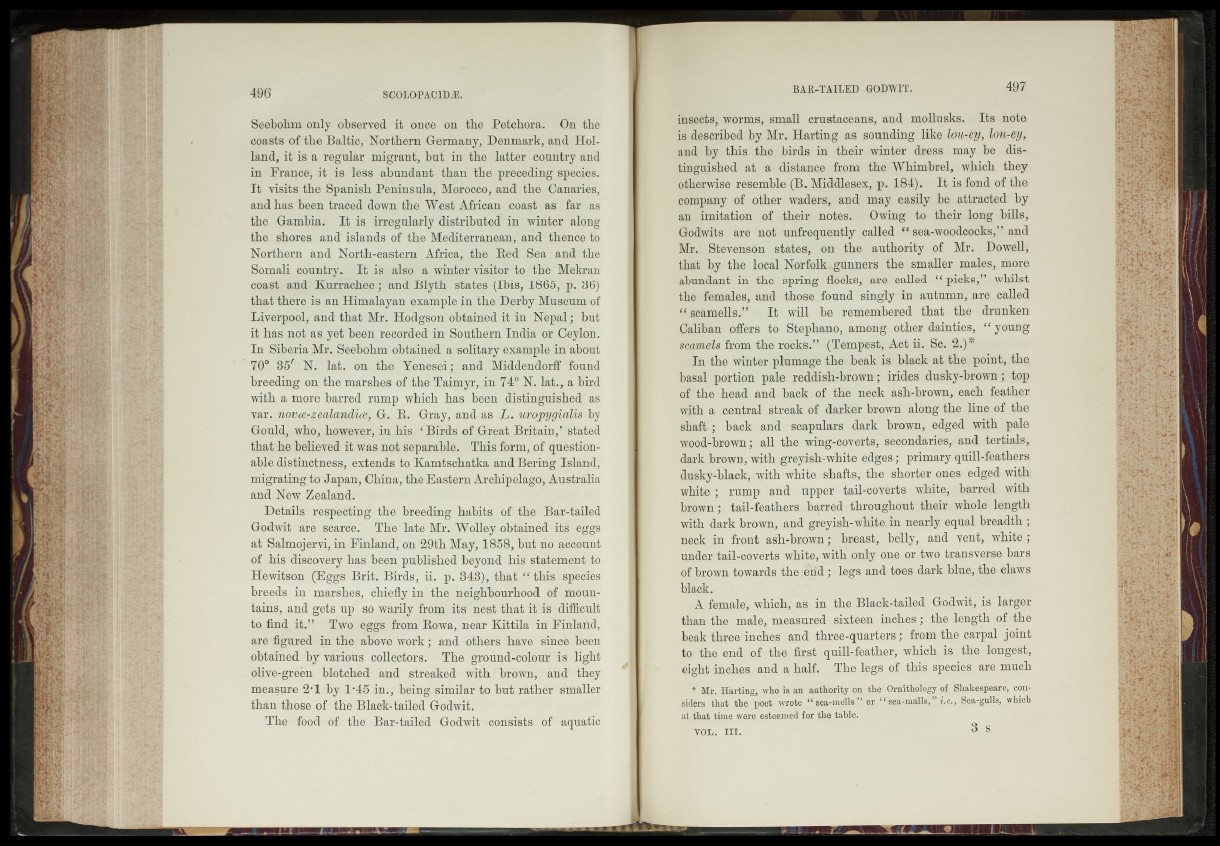
Seebohm only observed it once on the Petchora. On the
coasts of the Baltic, Northern Germany, Denmark, and Holland,
it is a regular migrant, butfin the latter' country and
in France, it is less abundant-than the preceding species.
It visits the Spanish Peninsula, Morocco, and,the Canaries,
and has been traced down the-West African coast as far as
the Gambia. It is irregularly distributed in/winter along
the shores and islands of the. Mediterranean, and thence to
Northern and North-eastern Africa, the Red Sea ■ and the
Somali country. It is also a winter visitor'to -the Mekran
coast and Kurrachee; and Blyth states (Ibis, 1865, p|%f)
that there is an Himalayan example in the Derby Museum of
Liverpool, and that Mr. Hodgson obtained it in Nopal; "but
it has not as yet been recorded in"Southern India ;ori@ey!on.
In Siberia Mr.;Seebohm obtaihed a solitary e'xaniple in "about
70° 85' N. lat. on the Yehesei;/ and ' Middendorff “found
breeding on the marshes of the Taimyr, in 740;N. lat., a third
with a more barred rump which has been* distinguished; as
var. novce-zealandice, Q-,. R, -.Gjay, and as’.-jL.’ umpygiqlis: by
Gould, who, however, in his ‘Birds of Gte&t Britain,’ stated
that he believed it was mot separable'. , Thjs-form, of questioiL-
able distinctness, extends to Kamtschatka-and Bering Island,
migrating to Japan,aCMfiay the Eastern Archipelago, Australia
and New Zealand;
. Details respecting .the/breeding habits ;s6,f th e Bar-tailed
Godwit are scarce. The late:Mr! Wol%yrobtaiffed^its'^ggs
a t Salmojervi, in. Finland"; on-20th May, 1’8'58, but no ’ account
of his' discovery has been published heyqndfhie-statement to
Hewitson :(Eggs B rit.-Birds’/ ii. p. 34-Siltfaat.“ this Saiiecies
breeds in marshes, .chiefly;in the-neighbourhood o f ’mountains,
|n d gets upHso wajily front its n e st th a t’TOfis “ difficult
to find it.” Two, eggs from Rowa, h®lr-Kittilafin.Finland,
are figured in 1 the above work; and others -have since'been
obtained' :by various collectors. The ground/colhurr i s . light
oldme?green: blotched and streaked* withJbrb$7np; and they
measure 2:1 :byAc4fi;im, ib^eihgr.similar to but rather smaller
than .those of the Blackmailed Godwit.' \
. The food of the Bar-tailed Godwit consists.; of aquatic
insects, worms, small crustaceans, and mollusks. Its note
is described by Mr. Harting as sounding like lovrty, lourey,,-
and by this the birds in their winter dress may be distinguished
at a distance from the Whimbrel, which they
otherwise resemble (B. Middlesex, p. 184)i|tdlt}is fond of the
company of other waders, and may easily be attracted by
an imitation of their notes,' Owing to their long bills,
Godwits are not unfraquently called “ sea-woodcocks,” and
Mr,' Stevenson states,- -on the authority of Mr. Dowell,
that .by the local Norfolk*gunners. the smaller males, more
abundant in the spring flocks, are called “ picks,” whilst
the females, and- thosa_ found singly in autumn, are called
“ scamells.” It - will :he. remembered that-the drunken
Caliban offers to Stephano, among gather-dainties, “ young
semnels ffenxfh® rocks,” -.(Tempest/ Act ii. Sc.
In the winter.plumage the. beak is black at the point, the
basal portion pale reddish-brown; irides dusky-brown / top
of the head and back.of -the neck ash-brown, each feather
wjth a v central .streak of darker brown along'the line. ,of mhfi
shaft ; back and scapulars dark brown,, edged. with pale
wood-*brown; all the wing-coverts, secondaries, and terfials,
dark brown, with greyish-white edges-; primary quill-feathers
dusky-black; with whiteshafts, the shorter,ones, edged; with
white.; rump and upper tail-coyerts w.hit§o» barred with
brpwn; fail-feathers, barred throughput their whole length,
with dark brown, and greyish-white, in nearly equal breadth
neck in , front ash-brown; breast, belly, and vent, white;
under tail-coverts white, with only one or two transverse bars
ofShwn. towards theie§"d ; legs and toes dark blue/ the daws
black.
female, which, as in ^^Blackmailed -Godwit'is larger
than the male, measured sixteen inches- fhe/length of the
beak three inches ;and three-quarters; from the carpal joint
to the end, first quill-feather, which/fi the longest,
eight inches, and a half. ,.Tlic legSiOf this species^are much
-A * Mr. Darting, who is an authority on the. Ornithology of-Shakespeare, considers
that the poet "®oM-<i/ea-melis ” or Pea-gulls, vthfcj|
-atthat time n ere <cste,gnie(| for the, tatble,^ - YOL. h i . ■ a mm